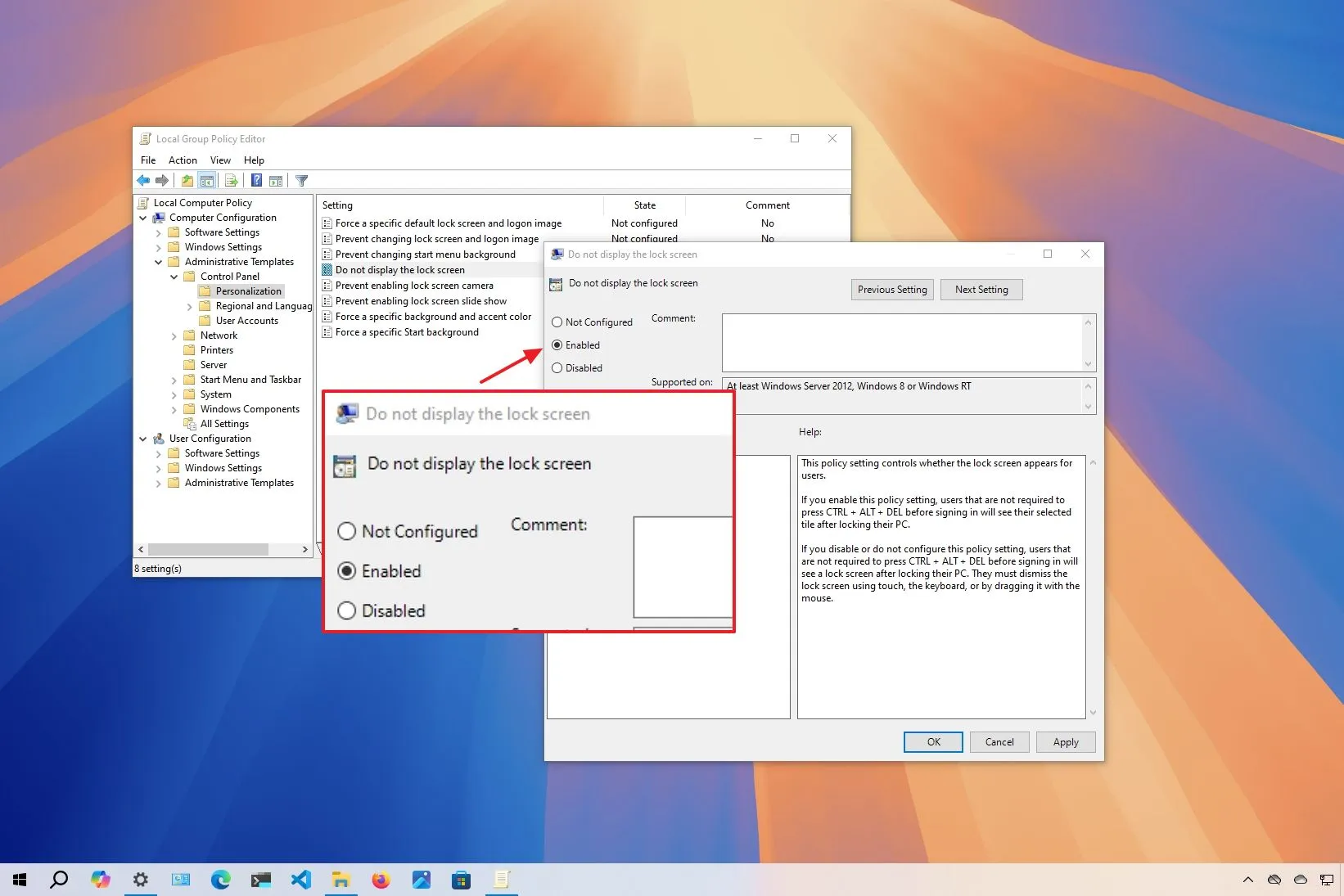- To disable the Windows 10 Lock Screen, open Group Policy > Computer Configuration > Administrative Templates > Control Panel > Personalization, open “Do not display the Lock Screen,” choose “Enabled,” apply the settings and restart the computer.
- You can also open the Registry, browse the “HKEY_LOCAL_MACHINE\SOFTWARE\Policies\Microsoft\Windows” path, create the “Personalization” key and the “Nolockscreen” DWORD and set the value to “1.”
- Alternatively, you can disable the login password to bypass the Lock Screen on Windows 10.
UPDATED 9/17/2024: On Windows 10, you can disable the Lock Screen to eliminate the extra step before signing in, and in this tutorial, I’ll show you the steps to complete this task. The Lock Screen is the first visual experience when the device starts and offers valuable information (such as date and time, weather, and app notifications) before you sign in. It also acts as a barrier to prevent unauthorized access to your computer when you’re away. When your computer is locked, you need to provide your credentials to unlock it. However, it adds an extra step to access your account.
Windows 10 does not include an option in the Settings app or Control Panel to turn off the Locks Screen experience. However, you can disable the feature using the Group Policy Editor or Registry. Alternatively, you can also disable the login password on your account to bypass the Lock Screen to access your desktop experience upon startup.
It’s important to note that disabling the Lock Screen might not be ideal for security reasons. Also, removing your account password will make the device vulnerable to unauthorized access locally and remotely. If you plan to proceed, use these instructions at your own risk.
In this guide, I will teach you three ways to remove the Lock Screen on Windows 10. (You can also perform the same configuration on Windows 11.)
Disable Windows 10 Lock Screen from Group Policy
If you’re running Windows 10 Pro, Enterprise, or Education, you can use the Local Group Policy Editor to turn off the first screen before signing in to your account.
To disable the Lock Screen through Group Policy on Windows 10 Pro, use these steps:
-
Open Start on Windows 10.
-
Search for gpedit, and select the top result to open the Local Group Policy Editor.
-
Browse the following path:
Computer Configuration > Administrative Templates > Control Panel > Personalization
-
Double-click the “Do not display the Lock Screen” policy.
-
Select the Enabled option to disable the Lock Screen.
-
Click the Apply button.
-
Click the OK button.
-
Restart the computer.
Once you complete the steps, the next time Windows 10 starts, you will be directly directed to the sign-in screen.
Disable Windows 10 Lock Screen from Registry
Although Windows 10 Home doesn’t include the Local Group Policy Editor, it is still possible to disable it by modifying the Registry. This method works in the Home edition as well as on Windows 10 Pro, Enterprise, and Education.
To disable the Lock Screen through the Registry, use these steps:
-
Open Start.
-
Search for regedit, and select the top result to open the Registry.
-
Browse the following path:
HKEY_LOCAL_MACHINE\SOFTWARE\Policies\Microsoft\Windows
-
Right-click the Windows key (folder), select the New submenu, and choose the Key option.
-
Name the key Personalization and press Enter.
-
Right-click the Personalization folder, select the New submenu, and choose the DWORD option.
-
Name the key Nolockscreen and press Enter.
-
Double-click the Nolockscreen key and set its value data from 0 to 1 to disable the Lock Screen.
-
Click the OK button.
-
Reboot the computer.
After you restart your computer, Windows 10 will bypass the Lock Screen and go straight to the sign-in screen.
Disable Windows 10 Lock Screen by disabling login password
If you don’t want to modify the Registry or you don’t have access to the Group Policy Editor, alternatively, you can configure the system to log in automatically, bypassing the Lock Screen and Sign-in Screen.
To remove the login to bypass the Lock Screen on Windows 10, use these steps:
-
Open Start.
-
Search for netplwiz and click the top result to open legacy User Accounts settings.
-
Select the account to remove the password under the “Users for this computer” section.
-
Clear the “User must enter a user name and password to use this computer” option.
-
Click the Apply button.
-
Confirm the Microsoft account credentials.
-
Click the OK button.
-
Click the OK button again.
Once you complete the steps, the computer will log in automatically, removing the Lock screen from the experience.
You also have multiple other ways to remove the login password from your device running Windows 10.
Update September 17, 2024: This tutorial has been updated to ensure accuracy and reflect new changes.
Source link
